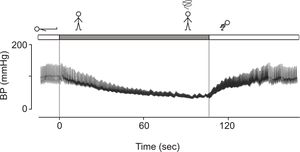Physical manoeuvres that reduce postural hypotension in autonomic failure
W. Wieling, J.J. van Lieshout, A.M. van Leeuwen
Department of Medicine, Academic Medical Centre, University of Amsterdam, Amsterdam (The Netherlands)
We describe a young female patient who was healthy until she presented with severe disabling orthostatic hypotension shortly after lymph node cancer, Hodgkin’s disease was diagnosed at an age of 22 years [1]. She even fainted when attempting to sit upright and was only able to move around sitting in a wheelchair with her knees drawn up. She also had a dry mouth, couldn’t perspire and found it hard to read. In addition, she had constipation with bouts of diarrhea and couldn’t pass urine easily.
Acute pandysautonomia, a generalized disorder of the autonomic nervous system, was diagnosed with the features of a hypoadrenergic orthostatic hypotension syndrome. In the cardio-vascular system she had an isolated sympathetic postganglionic lesion but, despite other features of parasympathetic impairment, had intact parasympathetic control of heart rate [2,3]
Treatment with chemotherapy and radiation resulted in complete remission of Hodgkin’s disease. Her saliva production, bowel movements and urinary bladder function returned to normal. Severe orthostatic hypotension however persisted, despite treatment with fludrocortisone 200 mcg daily. Warning symptoms of a very low blood pressure consisted of lightheadedness, visual disturbances, ringing in the ears, yawning and pain in the neck.
During this period, she discovered a series of manoeuvres which helped to reduce the symptoms of orthostatic hypotension. The light-headedness, which developed soon after arising from the supine position, was relieved by squatting (Fig. 1).
Editor's comments
| Table 2:Typical Premonitory Symptoms for Reflex Syncope |
|---|
|
References
<biblio>
- Wieling pmid=15310717
<biblio>
